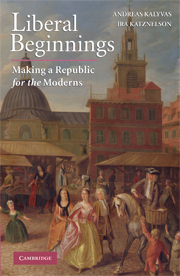Book contents
- Frontmatter
- Contents
- Acknowledgments
- 1 Beginnings
- 2 The Rhetoric of the Market: Adam Smith on Recognition, Speech, and Exchange
- 3 Agonistic Liberalism: Adam Ferguson on Modern Commercial Society and the Limits of Classical Republicanism
- 4 After the King: Thomas Paine's and James Madison's Institutional Liberalism
- 5 Embracing Liberalism: Germaine de Staël's Farewell to Republicanism
- 6 On the Liberty of the Moderns: Benjamin Constant and the Discovery of an Immanent Liberalism
- 7 After Republicanism: A Coda
- Index
- References
5 - Embracing Liberalism: Germaine de Staël's Farewell to Republicanism
Published online by Cambridge University Press: 05 September 2012
- Frontmatter
- Contents
- Acknowledgments
- 1 Beginnings
- 2 The Rhetoric of the Market: Adam Smith on Recognition, Speech, and Exchange
- 3 Agonistic Liberalism: Adam Ferguson on Modern Commercial Society and the Limits of Classical Republicanism
- 4 After the King: Thomas Paine's and James Madison's Institutional Liberalism
- 5 Embracing Liberalism: Germaine de Staël's Farewell to Republicanism
- 6 On the Liberty of the Moderns: Benjamin Constant and the Discovery of an Immanent Liberalism
- 7 After Republicanism: A Coda
- Index
- References
Summary
Recent studies in the history of modern political thought increasingly have been turning to the writings of Germaine de Staël. Intriguingly, this revival of interest in a body of thought long neglected by students of political ideas has been marked by a stark dualism. For some, she helps reconsider the character of republicanism. For others, her work clarifies the birth of continental, especially French, liberalism. Each version claims Staël as one of its canonical or foundational figures.
How might we come to terms with such different appraisals? Although her texts are both republican and liberal, they appear so not at the same time but in a sequence characterized by an internal trajectory, a movement from an originally republican to, ultimately, a decidedly liberal stance. First a republican, she increasingly distanced herself from this tradition to become a liberal. It is this shift we seek to understand. The challenge is to appreciate when, why, and how she said farewell to republicanism and embraced liberalism. We do so by identifying a moment of inflection in Staël's orientation.
Unlike others who ask us to choose between a republican or a liberal Staël, Lucien Jaume and Marcel Gauchet also focus on her intellectual transition and political transformation. Our analysis, though, differs from theirs. Jaume's account attributes changes in Staël's thought to both biographical and theoretical causes. He identifies her disenchantment with Bonaparte, whose coup d'état revealed immanent authoritarian and despotic possibilities in the newborn republic.
- Type
- Chapter
- Information
- Liberal BeginningsMaking a Republic for the Moderns, pp. 118 - 145Publisher: Cambridge University PressPrint publication year: 2008
References
- 1
- Cited by

